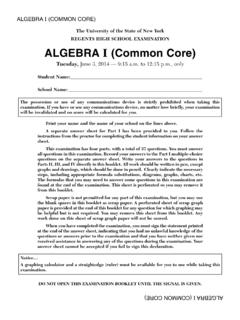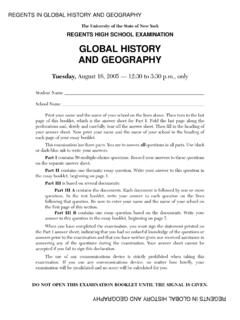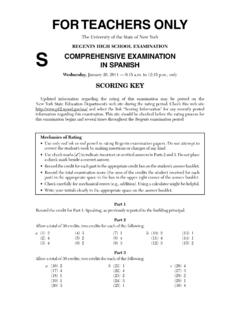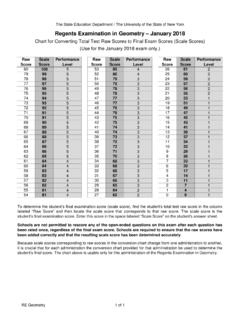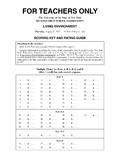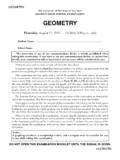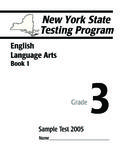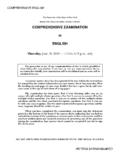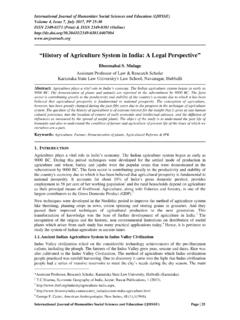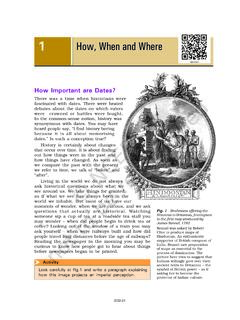Transcription of REGENTS EXAM IN GLOBAL HISTORY AND GEOGRAPHY II …
1 REGENTS EXAM IN GLOBAL HISTORY AND GEOGRAPHY II (GRADE 10). The University of the State of New York REGENTS HIGH SCHOOL EXAMINATION. REGENTS EXAM IN GLOBAL HISTORY . AND GEOGRAPHY II (GRADE 10). Thursday, January 23, 2020 9:15 to 12:15 , only Student Name _____. School Name _____. The possession or use of any communications device is strictly prohibited when taking this examination. If you have or use any communications device, no matter how briefly, your examination will be invalidated and no score will be calculated for you. Print your name and the name of your school on the lines above. A separate answer sheet has been provided to you.
2 Follow the instructions from the proctor for completing the student information on your answer sheet. Then fill in the heading of each page of your essay booklet. This examination has three parts. You are to answer all questions in all parts. Use black or dark-blue ink to write your answers to Parts II and III. Part I contains 28 multiple-choice questions. Record your answers to these questions as directed on the answer sheet. Part II contains two sets of constructed-response questions (CRQ). Each constructed- response question set is made up of two documents accompanied by several questions. When you reach this part of the test, enter your name and the name of your school on the first page of this section.
3 Write your answers to these questions in the examination booklet on the lines following these questions. Part III contains one essay question based on five documents. Write your answer to this question in the essay booklet. When you have completed the examination, you must sign the declaration printed at the end of the answer sheet, indicating that you had no unlawful knowledge of the questions or answers prior to the examination and that you have neither given nor received assistance in answering any of the questions during the examination. Your answer sheet cannot be accepted if you fail to sign this declaration. DO NOT OPEN THIS EXAMINATION BOOKLET UNTIL THE SIGNAL IS GIVEN.
4 REGENTS EXAM IN GLOBAL HISTORY AND GEOGRAPHY II (GRADE 10). Part I. Answer all questions in this part. Directions (1 28): For each statement or question, record on your separate answer sheet the number of the word or expression that, of those given, best completes the statement or answers the question. Base your answers to questions 1 and 2 on the passage below and on your knowledge of social studies. The sankin k tai (lit., alternate attendance ) system was a device of the Tokugawa shogunate, the government of Japan from 1603 to 1868, designed to insure political control by the regime over the daimyo, or territorial lords, who exercised virtually autonomous authority over the more than 260 feudal states into which four-fifths of the country was divided.
5 Under this system most of the daimyo were required to travel biennially [every two years] from their domains to the capital of the Tokugawa at Edo (present day Tokyo) and to spend alternate years in personal attendance at the shogunal court. Each daimyo was also required to maintain residences at the capital where his wife and children were permanently detained.. Another important contribution of the operation of the sankin k tai system to the modernization of Japan was to promote the intellectual and cultural unification of the country. The sankin k tai served to bring a large part of the leadership elements from the whole country together in one place and to keep a constant stream of leaders and intellectuals moving back and forth between the capital and all parts of the country.
6 This was important in giving Japan the tremendous intellectual unity with which it faced the West in the nineteenth century. It also enabled the people at large to have a stronger sense of national unity than would have been the case had the system not existed. By serving as the vehicle which spread the culture of Edo and Osaka to the countryside, the system influenced the diffusion of a truly national culture.. Source: Toshio G. Tsukahira, Feudal Control in Tokugawa Japan, East Asian Research Center, Harvard University, 1966. 1 What was an important contribution of the 2 The purpose of the Tokugawa's sankin k tai sankin k tai (alternate attendance) system to the (alternate attendance) system is similar to the modernization of Japan?
7 Purpose of (1) Japan's people developed a stronger sense of (1) british suffragettes who demanded Parliament national cultural unity. grant women the right to vote (2) Japan's government established control over (2) King Louis XIV of France who required Western intellectuals forced to live in Osaka. nobles to stay at Versailles (3) Japan improved its railroad system by (3) Sim n Bol var who expected the indigenous connecting the countryside to the cities. people to rise up against the Spanish (4) Japan increased the power of the daimyo (4) European countries that divided up the during the Tokugawa shogunate. African continent GLOBAL Hist.
8 & Geo. II Jan. '20 [2]. Base your answers to questions 3 and 4 on the passage below and on your knowledge of social studies..The poor harvest could not have come at a worse moment. France had entered into an unfavorable trade treaty with England in 1776. The pact reduced import duties on English goods, the notion being to encourage French manufacturers to mechanize production in response to enhanced competition. A flood of cheap imports from across the Channel overwhelmed the cloth industry. Cloth production alone fell by 50 percent between 1787. and 1789. The 5,672 looms in Amiens and Abbeville in 1785 were down to 2,204 by 1789. Thirty-six thousand people were put out of work, throwing many poor workers onto city streets at a time when hungry peasants were flocking to urban centers in search of food.
9 The rural crisis might have been short-lived had not urban unemployment mushroomed at the same time. In Paris, the government subsidized bread prices out of fear of the mobs, but to no avail. The situation was soon out of control.. Source: Brian Fagan, The Little Ice Age: How Climate Made HISTORY , 1300 1850, Basic Books, 2000. 3 Which claim related to the economic situation in 4 Which event was caused in part by the conditions 18th-century France is most directly supported described in this passage? by this passage? (1) collapse of the british Empire (1) A surplus of grain hurt French farmers. (2) French withdrawal from Mughal india (2) Subsidized bread prices led to improved (3) German wars of unification living conditions in French cities.
10 (4) French Revolution (3) economic competition with England led to agricultural innovation in France. (4) Efforts to stimulate industry in France through trade agreements caused unemployment. GLOBAL Hist. & Geo. II Jan. '20 [3] [OVER]. Base your answers to questions 5 and 6 on the excerpt below and on your knowledge of social studies. Excerpt from a letter by Chinese Commissioner Lin Zexu to Queen Victoria August 27, 1839.. Your country is more than 60,000 li [18,641 miles] from China. The purpose of your ships in coming to China is to realize a large profit. Since this profit is realized in China and is in fact taken away from the Chinese people, how can foreigners return injury for the benefit they have received by sending this poison to harm their benefactors?

